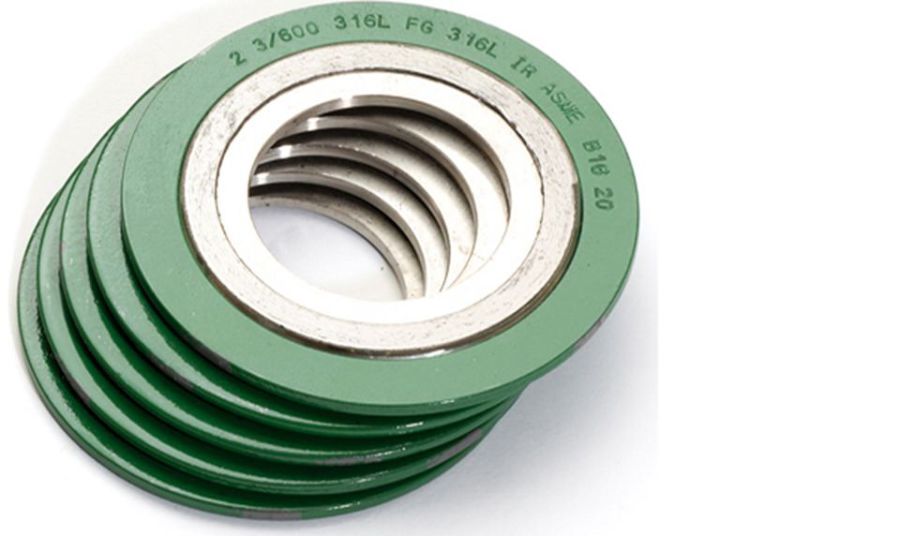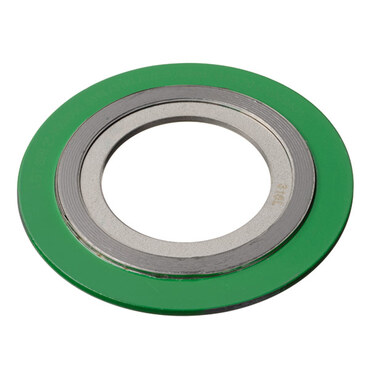Spiral Wound Gaskets
Manufactured in Accordance with ASME B16.20
Spiral wound gaskets made with an alternating combination of formed metal wire and soft filler materials—form a very effective seal when compressed between two flanges. A v-shaped crown centered in the metal strip acts as a spring, giving gaskets greater resiliency under varying conditions. Filler and wire material can be changed to
Accommodate different chemical compatibility requirements. Fire safety can be assured by choosing flexible graphite as the filler material. If the load available to compress a gasket is limited, gasket construction and dimensions can be altered to provide an effective seal.
A spiral wound gasket may include a centering ring, an inner ring or both. The outer centering ring centers the gasket within the flange and acts as a compression limiter, while the inner ring provides additional radial strength. The inner ring also reduces flange erosion and protects the sealing element.
Resiliency and strength make spiral wound gaskets an ideal choice under a variety of conditions and applica-tions. Widely used throughout refineries and chemical processing plants, spiral wound gaskets are also effective

for power generation, pulp and paper, aerospace, and a variety of valve and specialty applications.
As set forth in ASME B16.20, all PTFE filled spiral wound gaskets will be supplied with inner rings. In addition, the following higher pressure class spirals will be supplied with inner rings for all filler material:
■ NPS 24 and larger 900#
■ NPS 12 and larger 1500#
■ NPS 4 and larger 2500#
Starting in May 2008, the metricated edition of this standard recommends the use of inner rings for all graphite filled spiral wound gaskets. However, these gaskets may be specified without inner rings by the purchaser. Both styles will still be stamped ASME B16.20 compliant on the outer guide ring.

Performance Metrics
Controlled Density™ Process
■ manufacturing process ensures optimum filler density across the gasket winding to achieve consistent compression and superior salability
■ High tightness level achieved with minimal compressive load,
■ for longer-lasting seal
■ All SW gaskets manufactured in accordance with
the guidelines set forth in the ASME B16.20 specifications
ROTT Test and Results
ROTT Test
■ Purpose: Determine room temperature sealing
■ capabilities, by measuring the seal ability of a gasket
at incremental gasket stress values
■ Sample used: Two 304 SS and flexible graphite-filled 4″ Class 150 ASME B16.20 spiral wound gaskets
■ Procedure: The leak rate is measured during the Loading and unloading cycles, and a tightness Curve is generated.*

| Gasket Material | Gasket | Gasket | Gasket | Stress Req’d | Stress Req’d | Stress Req’d | |
| Constant | Constant | Constant | for Tightness | for Tightness | for Tightness | ||
| Gb (psi) | ‘a’ | Gs (psi) | of 100 (psi) | of 1000 (psi) | of 10,000 (psi) | ||
| flexible graphite- | |||||||
| filled spiral wound gasket | 627 | 0.35 | 6.22 | 3,140 | 7,040 | 11,430 | |
| (ASME B16.20) | |||||||
| Flexible graphite spiral wound | 2,300 | 0.237 | 13 | 6,851 | 11,823 | 20,405 | |
| gasket | |||||||
| PTFE-filled spiral wound gasket | 4,500 | 0.14 | 70 | 8,575 | 11,836 | 16,339 | |
| Foil-reinforced flexible graphite sheet | 816 | 0.377 | 0.066 | 4,631 | 11,033 | 26,284 | |
| GRAPHONIC® gasket | 315 | 0.36 | 1.857 | 1,653 | 3,787 | 8,676 | |
| “Low stress” spiral wound type | 598 | 0.385 | 0.03 | 3,520 | 8,540 | 14,570 | |
| gasket, flexible graphite filled | |||||||
| Kammprofile gasket | 368 | 0.4 | 0.28 | 2,324 | 5,838 | 14,664 | |
